The first professional football player, by name alone, sounds too perfect to be true — more like a mythical god of the gridiron than a living, breathing human being.
But Pudge Heffelfinger was as real as the broken ribs he brutally delivered to a poor college kid while scrimmaging for kicks and giggles with the Yale varsity football team — at 49 years old.
This groundbreaking goliath of American sports was “unquestionably the most amazing football player I had ever known,” wrote legendary sportswriter Grantland Rice of the man in the introduction to Heffelfinger’s own book.
A Paul Bunyan-esque behemoth from Minnesota, Heffelfinger was tall, strapping, handsome — and ferocious.
MEET THE AMERICAN WHO GAVE THE NATION OUR THANKSGIVING ORIGIN STORY: PILGRIM EDWARD WINSLOW
He starred for Yale from 1888 to 1891 and was the best player on some of the most dominant teams in college football history.
A year after manhandling overmatched college opponents, Heffelfinger reshaped America’s favorite sport forever.

William Walter “Pudge” Heffelfinger was a strapping 6-foot-3, 205-pound lineman for the dominant Yale teams of 1888 to 1891. He became the first professional football player in 1892, when the Allegheny Athletic Association paid him $500 to play against the rival Pittsburgh Athletic Club.
(Courtesy Pro Football Hall of Fame)
He was paid $500 to take the field for the Allegheny Athletic Association in an 1892 contest against the rival Pittsburgh Athletic Club.
In that moment, Heffelfinger likely entered history as the first pro football player.
“Other players may have been paid to play before him — we don’t know for sure,” sports historian Ken Crippen, founder of The Football Learning Academy, told Fox News Digital.
“Pudge Heffelfinger was unquestionably the most amazing football player I had ever known.” — Grantland Rice
“But Heffelfinger was the first for whom we have proof. After Heffelfinger, you started seeing a shift toward teams openly paying players. You were going to get the best players by throwing money at them.”
Heffelfinger also proved to be one of the great ironmen in sports history.
He played competitive football at one level or another well into his 60s, after college as a barnstorming mercenary and in later years as a celebrity figure at charity games.

Grantland Rice (left) and Joe E. Brown (right) at the Santa Anita races. Rice is known for, among other things, crafting legendary phrases such as “The Four Horseman of Notre Dame.” He called Pudge Heffelfinger “the most amazing football player I had ever known.”
(Bettmann Archive/Getty Images)
“In 1916, at age 49, he scrimmaged against the Yale varsity. In 1920, age 53, he played 50 minutes for the East All-Stars against the Ohio State All-Stars at Columbus, Ohio,” says the National Football Foundation.
“In 1930, age 63, he made his final appearance in a football uniform in an all-star game at Minneapolis.”
Other sources put his last game at age 65, in a charity event for World War I veterans in 1932.
ALABAMA ‘FRIENDSGIVING’ DINERS TIP WAFFLE HOUSE WAITRESS $1,125: ‘NORMALIZE BEING KIND’
This almost super-human figure coached football, mentored players and championed football in media.
He lent his name to popularize the game, publishing the sports annual “Heffelfinger’s Football Facts,” featuring news, stats and schedules for both pro and college football, from 1935 to 1950.
“I stuck with the game longer than anybody else did.”
In his later years, Heffelfinger embraced his unique legacy as the first professional football player and the sport’s ageless wonder.
“It has been said by some historians that I will go down as ‘the greatest player of all time,'” Heffelfinger wrote in 1954, the year he died, in a biography called “This Was Football.”
“Deep in my heart I know it’s not true,” he said. “I can honestly claim, however, that I stuck with the game longer than anybody else did. On and off, I was an active football player 50 years.”
Born into a new era of sports
William Walter “Pudge” Heffelfinger was born on Dec. 20, 1867, in Minneapolis to Christopher and Mary Ellen (Totton) Heffelfinger.
His father was a Civil War veteran wounded at Gettysburg, who then built a prominent shoemaking business in Minneapolis.
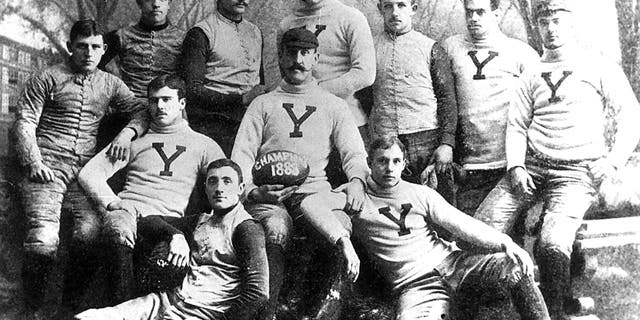
Yale University’s 1888 football team, coached by Walter Camp, went 13-0 and outscored its opposition 694-0. Pudge Heffelfinger (back row, center) towered over his teammates.
(Photo by ullstein bild via Getty Images)
“Pudge wasn’t really pudgy,” Richard Goldstein wrote in his 1996 book “Ivy League Autumns,” a chronicle of the early days of a sport created and dominated by elite East Coast institutions.
“He picked up the nickname while playing sandlot football in Minneapolis at age 15.”
Heffelfinger was born into a nation on the cusp of the sport-as-entertainment explosion that followed the Civil War.
MEET THE AMERICAN WHO INSPIRED THE NATION IN TWO WORLD WARS: CHRISTIAN SOLDIER SGT. ALVIN YORK
The Cincinnati Red Stockings, the first professional baseball team, played their first game in the spring of 1869. In the autumn of that same year, Rutgers and Princeton battled in the first college football game.
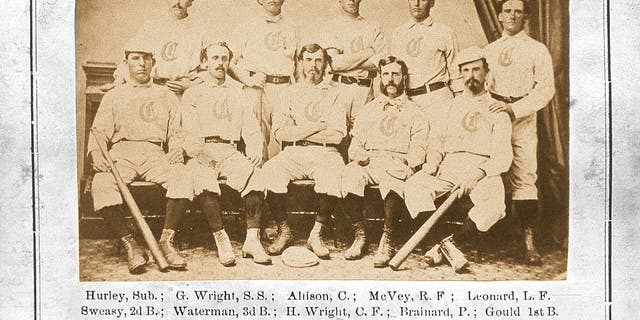
The Red Stocking Baseball Club of Cincinnati, Ohio, poses for a team photo in 1869, which was issued as a trade card. The Red Stocking, the first pro baseball team, and the first college football game, both emerged in 1869 — part of a post-Civil war obsession with sports as entertainment.
(Mark Rucker/Transcendental Graphics, Getty Images)
Heffelfinger became a schoolboy legend in this new sports-crazy, post-war America.
He starred in both baseball and football at Central High School in Minneapolis. (It’s the same high school that produced music legend Prince — before closing in 1982.)
MEET THE AMERICAN WHO SHAPED MODERN FOOTBALL: WALTER CAMP, PIGSKIN PIONEER
His athletic exploits gave Heffelfinger the opportunity to play at Yale, the best college program in America, under coach and pigskin pioneer Walter Camp, widely proclaimed as the father of modern football.
“Playing left guard, Heffelfinger was extremely quick, powerful, intelligent and fearless,” Goldstein wrote. “He pounced on opponents while playing defense and led the line charge on offense, springing from a semi-erect stance.”
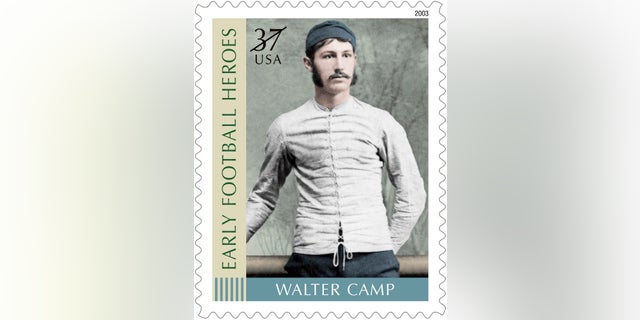
The U.S. Postal Service issued a Walter Camp stamp in 2003 to pay tribute to his unparalleled contributions to American football. Pudge Heffelfinger played for Walter Camp at Yale.
(United States Postal Service)
Added Goldstein, “Heffelfinger’s specialty was moving to the right, then turning in to lead interference for a Tennessean named Thomas (Bum) McClung, Yale’s star halfback.”
Yes, Heffelfinger was football’s first pulling guard. It’s still a dramatic feature of the game today, requiring large, muscular players with unusual athletic dexterity to lead fleet-footed ball carriers around the edge of a defense.
“Playing left guard, Heffelfinger was extremely quick, powerful, intelligent and fearless.” — author Richard Goldstein
Listed at 6 foot, 3 inches and 205 pounds, Heffelfinger was a giant in his day. Towering over his teammates, he helped Yale dominate college football.
He was a three-time All American performer and would have earned the honor four times, notes Goldstein, but for the fact that the award wasn’t introduced until his sophomore season.
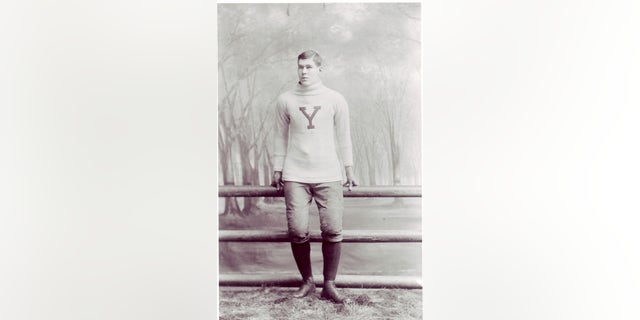
Pudge Heffelfinger starred at Yale from 1888 to 1891. Despite his nickname, he was not pudgy. But he towered over other players of the era.
(Courtesy Pro Football Hall of Fame)
The 1888 Yale team, his freshman year, went 13-0 and outscored its opponents 694-0. It was the single most dominant team in more than 150 years of college football history.
“By the time his days at Yale had finished, ‘Pudge’ not only lettered in football, but he also lettered in baseball, rowing and track,” reports the Pro Football Hall of Fame. He was reportedly the only four-letter athlete in Yale history.
Heffelfinger left the college game recognized as football’s greatest player.
Pro football’s birth certificate
Pro football as Americans know it today grew out of community and company football clubs in the “Gridiron Breadbasket” of western Pennsylvania and Ohio.
These still-amateur teams were boosted by the growing popularity of college football, which became a national phenomenon during Heffelfinger’s glory days at Yale.
The Allegheny Athletic Association was founded on the north side of Pittsburgh in 1890, often fielding former college stars and competing against college programs.
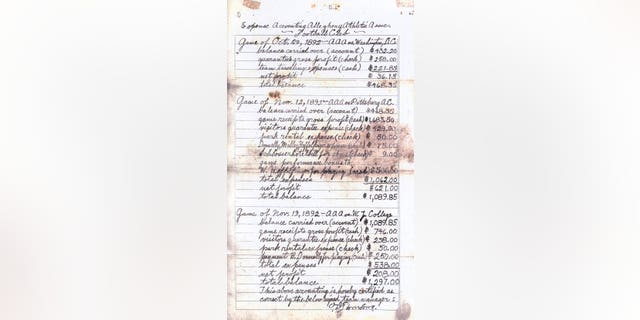
Pro football’s “birth certificate”: Dated Nov. 12, 1892, this Allegheny Athletic Club expense accounting sheet lists “game performance bonus to W. Heffelfinger for playing (cash) $500.00.” The ledger notation is the earliest evidence of a player being paid to play football.
(Courtesy Pro Football Hall of Fame)
“The new club was a natural rival to the older Pittsburgh Athletic Club but labored under several disadvantages,” writes the Pro Football Researchers Association.
“Not only did the P.A.C. have several years’ headstart on the Three A’s, but, more important, the older club had its excellent east end gymnasium.”
The “Triple A’s” sought to level the playing field the old-fashioned way: with money.
A handwritten ledger from the Allegheny Athletic Club shows an entry on Nov. 12, 1892 for “game performance bonus to W. Heffelfinger for playing (cash) $500.00.”
The Hall of Fame in Canton, Ohio, calls the document “Pro Football’s Birth Certificate.”
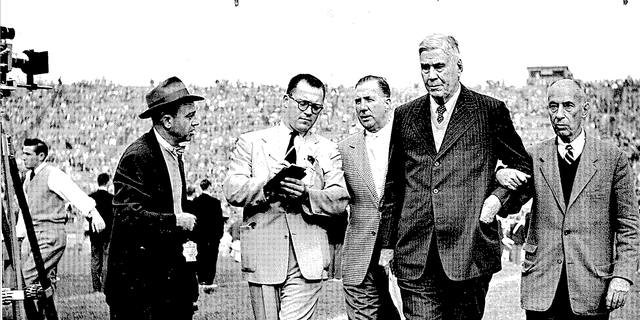
Pudge Heffelfinger was a Paul Bunyan-esque figure from Minnesota. He still towered over other men while being honored at an undated football game later in life. He continued to play football until his mid 60s.
(Courtesy Pro Football Hall of Fame)
“Apparently, he was well worth it, as the Allegheny Athletic Club defeated the Pittsburgh Athletic Club, 4-0,” writes the Pro Football Hall of Fame.
“Heffelfinger recovered a fumble and returned it [25 yards] for a touchdown for the game’s only score. Touchdowns were worth just four points in 1892.”
The Allegheny Athletic Club netted a tidy $621 profit for the day, despite devoting nearly half the team’s $1,062 in expenses to Heffelfinger. The payout was big money at the time.
“The average annual income of a Pennsylvania family in 1892 was $834,” Pudge’s great-great-nephew, Tom Heffelfinger, told the Minneapolis Star-Tribune in 2018.
MEET THE AMERICAN WHO FIRST COMMANDED THE MARINES: REVOLUTIONARY WAR HERO SAMUEL NICHOLAS
The story of Pudge Heffelfinger, the first professional football player, lived on only in word of mouth and hazy legend for nearly 75 years.
History changed in the 1960s when a mysterious man walked into the office of Pittsburgh Steelers president Dan Rooney.
“After a brief discussion, the man gave Rooney a typed, 49-page manuscript about the early history of pro football,” the Pro Football Researchers Association reported in 1989.
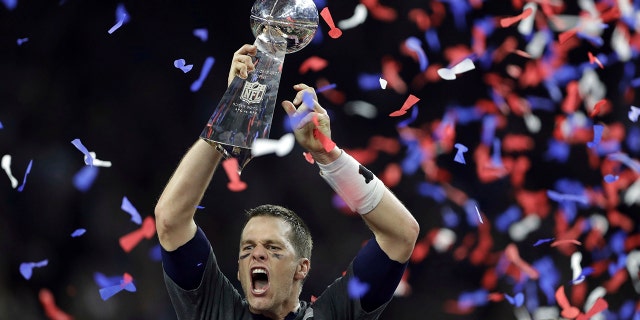
In this Feb. 5, 2017, file photo, New England Patriots’ Tom Brady raises the Vince Lombardi Trophy after defeating the Atlanta Falcons in overtime at the NFL Super Bowl 51 football game in Houston. Pro football today is a $17 billion-a-year business.
(AP Photo/Darron Cummings, File)
“When Rooney read the paper, he realized he had a piece of research of incalculable importance. Unfortunately, by that time, the man had departed.
As best Rooney could recall, the visitor’s name was Nelson Ross. But although Rooney tried to track down Ross, the man never resurfaced.
The Pro Football Hall of Fame dug into the story, and found in its files the ledger entry from the Allegheny Athletic Association showing the details of the day it made Heffelfinger the first pro football player.
The practice of paying players was formalized in 1920 with the creation of the American Professional Football Association. Two years later, it was renamed the National Football League.
‘Forever young’
William Walter Heffelfinger died on April 2, 1954, in Blessing, Texas. He was 86 years told.
The Texas Historical Commission memorialized the football great with a signpost tablet placed outside his burial site at Hawley Cemetery in Blessing.
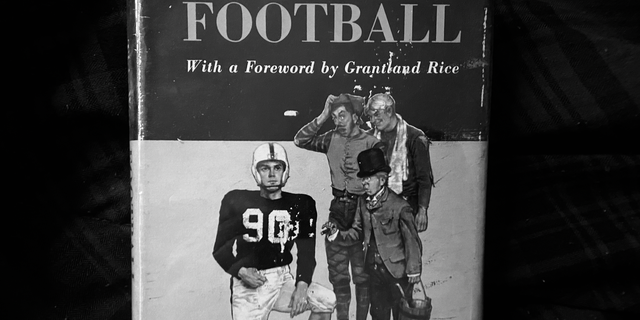
Wiliam Walter “Pudge” Heffelfinger, who played football into his 60s, chronicled his groundbreaking sports journey in the 1954 book, “This Was Football.”
(Kerry J. Byrne/Fox News Digital)
It highlights his many contributions to the game, including his advent of the pulling guard and his induction into the College Football Hall of Fame in 1951.
Heffelinger enjoyed quite a life outside football, as politician, businessman and media mogul.
“Pudge gave forth an aura of shining light, a special, ageless glory … the living symbol of the game, indestructible and forever young.” — Grantland Rice
“He was a Minnesota delegate to the Republican National Conventions in 1904 and 1908. He served as Hennepin (Minnesota) County Commissioner from 1924-48 and even ran, although unsuccessfully, for Congress in 1930,” writes the Pro Football Hall of Fame.
But it was the moment in 1892, when his $500 exploits paid off in victory for the Allegheny Athletic Association, that heralded a new era in American culture.
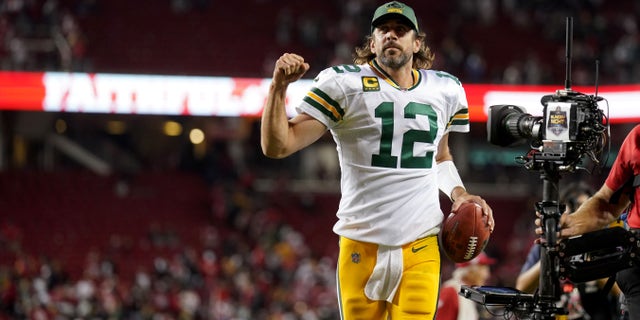
Green Bay Packers quarterback Aaron Rodgers (12) jogs toward the locker room after the Packers defeated the San Francisco 49ers 30-28 at Levi’s Stadium in September 2021.
(Cary Edmondson-USA TODAY Sports)
Professional football today is the great colossus of global sports. Its popularity in America is rivaled only by college football; its profitability around the world is matched by no other sport.
CLICK HERE TO SIGN UP FOR OUR LIFESTYLE NEWSLETTER
The National Football League generated $17.2 billion in revenue in 2021. The biggest soccer league, the English Premier League, generates less than half the revenue as the NFL, despite its greater global popularity.
Game-day pay has grown dramatically in the 130 autumns since Pudge pocketed five bills.
Green Bay Packers quarterback Aaron Rodgers, the top-paid player in the NFL today, makes about $2.9 million per game.
Heffelfinger likely would have marveled at the changes.
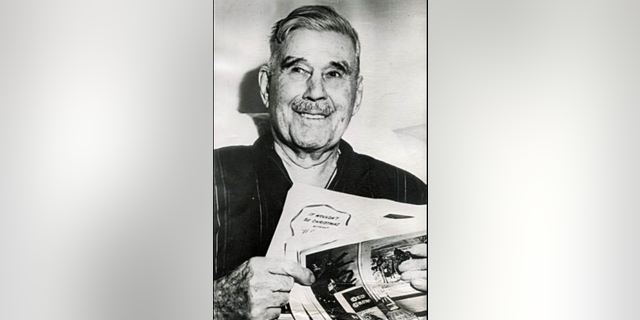
Pudge Heffelfinger at age 82 in Blessing, Texas, around 1950. He died at age 86 in 1954. Heffelfinger was the first athlete paid to play football. He continued to play competitive football until age 64.
(Public domain)
“I’d love to live another 86 years — just the see what’s around the corner!” he enthused in his book, “This Was Football,” published the year he died.
Grantland Rice dug deep into the well of English-language literature to find ways to pay homage to Heffelfinger.
CLICK HERE TO GET THE FOX NEWS APP
“To borrow a line from old Bill Shakespeare: ‘Cowards die many times before their death. The valiant never taste of death but once,” wrote Rice.
“Pudge gave forth an aura of shining light, a special, ageless glory. He was the living symbol of the game, indestructible and forever young.”
To read more stories in this unique “Meet the American Who…” series from Fox News Digital, click here.
Hits: 0










